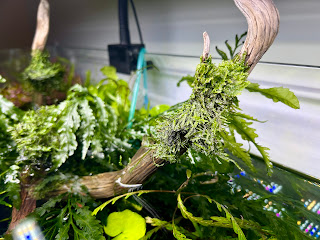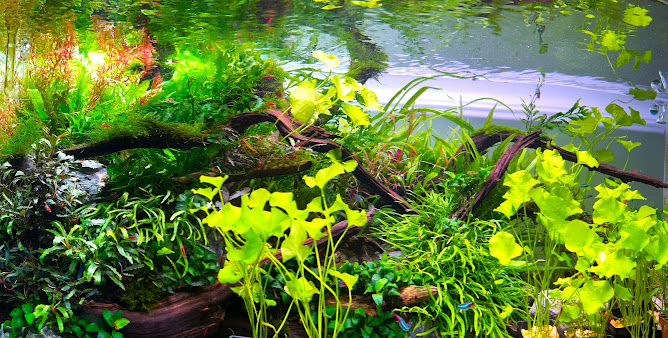GH Creep in a Freshwater Aquarium Explained: Why Topping Off Isn’t Enough & How to Prevent it
Many aquarists rely on topping off instead of regular water changes, or perform infrequent water changes. These practices, while convenient, can lead to serious problems, including "GH Creep" and the accumulation of other harmful substances in the water. GH Creep refers to the gradual increase in General Hardness (GH), measured in degrees of German hardness (°dH), in aquarium water due to the accumulation of minerals. This article explains why, comparing a theoretical ideal with a typical home aquarium.
Scenario 1: The Perfectly Controlled, Empty Tank
Imagine a sterile tank with just 100 liters of water at a GH of 6 °dH and a KH of 3 °dH. Consistent water changes use replacement water with identical GH and KH values. Even evaporation is precisely controlled. In this idealized system, GH and KH remain perfectly stable because no internal or external factors alter mineral concentrations.
Scenario 2: The Real-World Aquarium
A 100-liter aquarium is set up with substrate, hardscape, plants, and livestock. The initial water is a GH of 6 °dH and a KH of 3 °dH, and CO2 injection is used. Evaporation is addressed with dechlorinated tap water, which likely does not match the aquarium's GH and KH. Over several months, water changes become infrequent, perhaps once or twice a month, and GH and KH testing is neglected. Eventually, the water is tested and reveals a significant increase to a GH of 14 °dH and a KH of 7 °dH.
What causes this "GH Creep" in a real-world aquarium? Several factors contribute:
Substrate: Gravel, crushed coral, aragonite, and some plant substrates leach minerals. Limestone-based materials are particularly notorious for releasing calcium and magnesium carbonates, raising both GH and KH.
Hardscape: Sedimentary rocks like limestone and dolomite significantly increase GH and KH, especially in CO2-injected planted tanks. The dissolved CO2 forms carbonic acid, increasing the solubility of calcium carbonate and accelerating leaching. Driftwood and some resin decorations can also leach minerals. Shells and coral skeletons drastically increase both GH and KH.
Fish Food and Waste: Fish food contains minerals, which are released as uneaten food decomposes and as fish metabolize. This adds to the mineral load.
The Problem with Topping Off
Topping off only replaces evaporated water; it does not remove accumulated minerals or waste. Therefore, regardless of whether the top-off water has a higher, lower, or identical mineral concentration to the aquarium water, topping off alone cannot prevent GH creep. Even topping off with pure RO/DI water will not prevent GH creep, as the minerals are still being added to the system by other means. Topping off essentially acts as a weak partial water change, temporarily lowering GH/KH from their current levels, but failing to remove the accumulated minerals. As evaporation continues, the mineral concentration will still rise.
The Inadequacy of Infrequent Water Changes
Infrequent water changes also contribute to GH creep. Even if topping off wasn't a factor, the absence of regular water changes allows minerals from the substrate, hardscape, food, and waste to accumulate.
The Solution: Regular Water Changes
Regular and sufficient water changes are essential for mitigating mineral and waste accumulation. They are the only effective way to remove the minerals that cause GH creep and the other harmful substances that build up in aquarium water. These substances include fish waste (ammonia, nitrite, and nitrate), phosphates (which fuel algae growth), dissolved organic compounds, excess minerals, fish hormones, and potentially harmful metals. All of these negatively impact the health of fish and plants, even if the water appears clear. While managing mineral input from other sources (substrate, hardscape) can help, it cannot replace the need for regular water changes. Regular water changes are the cornerstone of a healthy aquarium.
Water Changes and Beneficial Bacteria
The fear of disrupting the delicate biological processes, especially the beneficial bacteria, is a common concern. It's a misnomer to think water changes harm them; neglecting water changes is far more detrimental. Poor water quality weakens and kills these bacteria, leading to ecosystem problems.
These microscopic allies are crucial for converting harmful fish waste into less toxic substances, and they colonize surfaces throughout the aquarium—filter media, gravel, decorations—not the water column itself. This is a key point: water changes won't wash away a significant portion of the bacteria population. Beneficial bacteria, like fish and plants, thrive in stable, healthy water. They actually benefit from regular water changes, which replenish minerals, remove nitrates, and maintain a balanced pH.
The key to safe water changes lies in mimicking existing tank conditions as closely as possible. This means matching both general hardness (GH), measured in °dH, and carbonate hardness (KH), also measured in °dH. Sudden shifts in either can stress fish and bacteria. KH is especially important as it buffers pH, preventing harmful swings. By matching GH and KH, you're also stabilizing pH.
Matching temperature, GH, KH, and oxygenation ensures a smooth transition, allowing biological processes to continue uninterrupted. It's not the water change itself that's risky, but how it's done, which will be covered in another article.

.jpg)

.jpg)
Comments